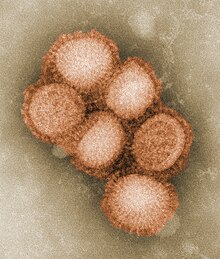| Swine influenza | |
|---|---|
| Other names | Pig influenza, swine flu, hog flu, pig flu |
 | |
| Electron microscope image of the reassorted H1N1 influenza virus photographed at the CDC Influenza Laboratory. The viruses are 80–120 nanometres in diameter.[1] | |
| Specialty | Infectious disease |
Swine influenza is an infection caused by any of several types of swine influenza viruses. Swine influenza virus (SIV) or swine-origin influenza virus (S-OIV) refers to any strain of the influenza family of viruses that is endemic in pigs.[2] As of 2009, identified SIV strains include influenza C and the subtypes of influenza A known as H1N1, H1N2, H2N1, H3N1, H3N2, and H2N3.[3]
The swine influenza virus is common throughout pig populations worldwide. Transmission of the virus from pigs to humans is rare and does not always lead to human illness, often resulting only in the production of antibodies in the blood. If transmission causes human illness, it is called a zoonotic swine flu. People with regular exposure to pigs are at increased risk of swine flu infections.
Around the mid-20th century, the identification of influenza subtypes was made possible, allowing accurate diagnosis of transmission to humans. Since then, only 50 such transmissions have been confirmed. These strains of swine flu rarely pass from human to human. Symptoms of zoonotic swine flu in humans are similar to those of influenza and influenza-like illness and include chills, fever, sore throat, muscle pains, severe headache, coughing, weakness, shortness of breath, and general discomfort.
It is estimated that, in the 2009 flu pandemic, 11–21% of the then global population (of about 6.8 billion), equivalent to around 700 million to 1.4 billion people, contracted the illness—more, in absolute terms, than the Spanish flu pandemic.[citation needed] There were 18,449 confirmed fatalities. However, in a 2012 study, the CDC estimated more than 284,000 possible fatalities worldwide, with numbers ranging from 150,000 to 575,000.[4][5] In August 2010, the World Health Organization declared the swine flu pandemic officially over.[6][7]
Subsequent cases of swine flu were reported in India in 2015, with over 31,156 positive test cases and 1,841 deaths.
- ^ International Committee on Taxonomy of Viruses. "The Universal Virus Database, version 4: Influenza A". Archived from the original on January 13, 2010.
- ^ Wells T (2008). "Swine influenza". The Merck Veterinary Manual. CreateSpace Independent Publishing Platform. ISBN 978-1-4421-6742-1. Archived from the original on March 4, 2016. Retrieved April 30, 2009.
- ^ Chandra S, Bisht N (2010-03-01). "Swine Influenza". Apollo Medicine. 7 (1): 21–31. doi:10.1016/S0976-0016(12)60003-9. ISSN 0976-0016. S2CID 263480804.
- ^ "CDC estimate of global H1N1 pandemic deaths: 284,000". CDC. 27 June 2012. Retrieved 13 April 2020.
- ^ "First Global Estimates of 2009 H1N1 Pandemic Mortality Released by CDC-Led Collaboration". CDC. 20 November 2019. Retrieved 27 March 2020.
- ^ "Pandemic (H1N1) 2009". Archived from the original on April 28, 2009.
- ^ "Swine Flu". National Health Portal of India. Archived from the original on 2022-08-16. Retrieved 2017-09-21.